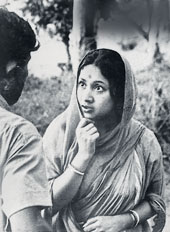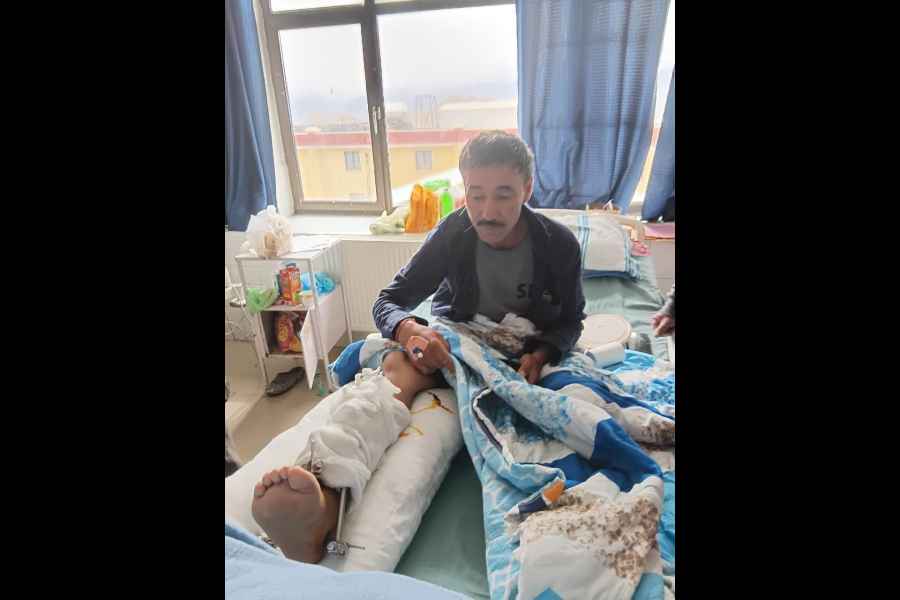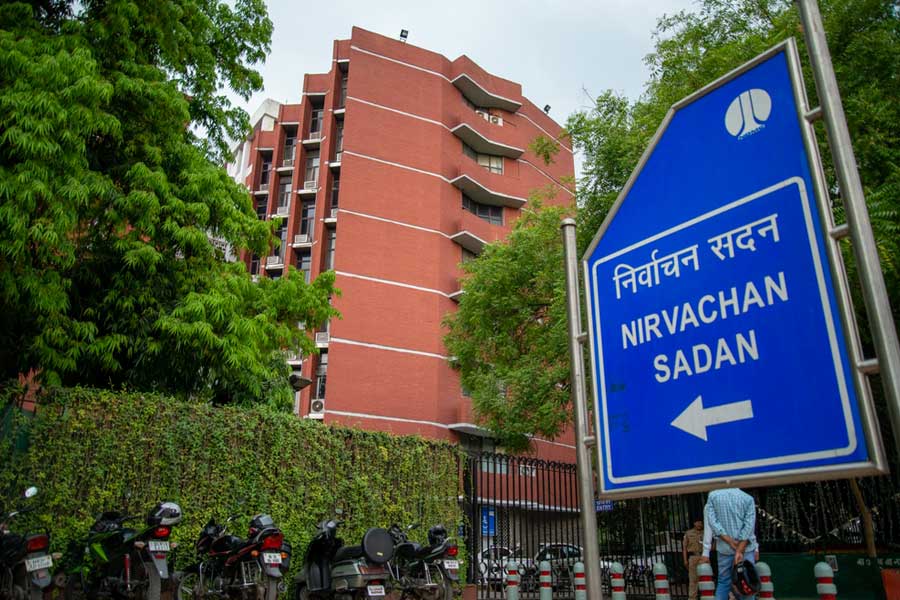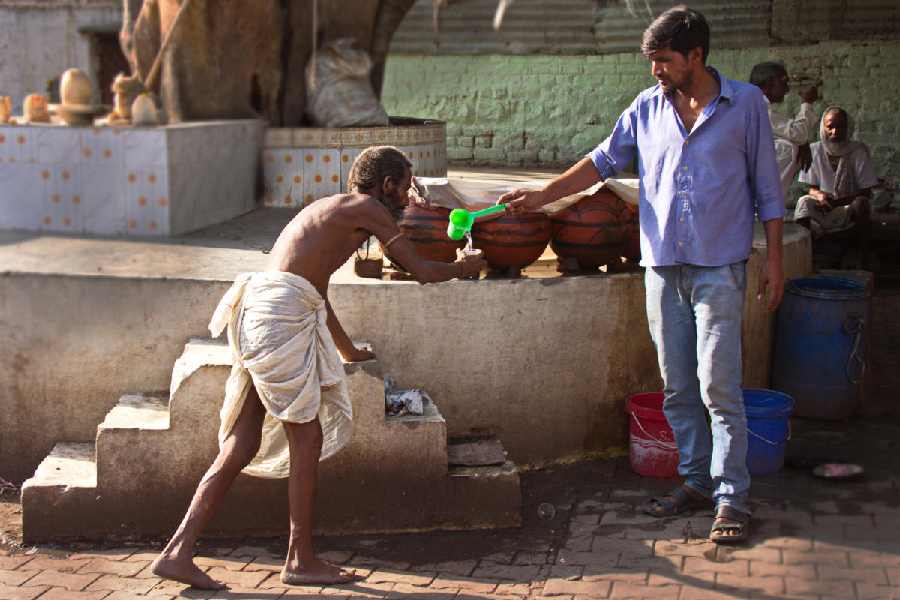 |
| Consent or force? A still from Ashani Sanket, where Sandhya Roy plays a village woman who trades her virtue for a handful of rice |
There are three villages called Raghunathpur near Lakshmikantapur. Hasina used to live in one of these. Locating the village is not easy. The only clue is the name of Hasina’s parents.
Hasina was sold to a brothel in Pune, rescued and brought to a rehabilitation centre run by an NGO in Calcutta in April 2006. In August the same year, she was sent back home, “restored” in NGO parlance. The NGO, Sanlaap, has now embarked on a project to find out how the girls who went back home are.
But finding Hasina proves even more difficult than finding her village.
Her Raghunathpur, about 20 km from Lakshmikantapur, is a pristine village that looks uncorrupted — only mud-huts, neat and still, picture-like, under trees in the rain. But the signs of poverty are everywhere. Hasina’s house is a mud-hut with a teeming family; her father, an agricultural labourer, is away at work, but her stepmother is at home, as are many children of school-going age. No one is willing to speak about Hasina.
“She got married,” says the stepmother. Apparently to a man from Lakshmikantapur who makes leather bags. Neighbours collect; some smirk at the mention of her name. How did Hasina meet this man? Did they have a proper wedding? Are there photographs? Is she all right?
No one knows. It is as if by landing in a brothel, she has given up the right to community: it’s best that she behaves like a secret hushed up. There’s a whiff of scandal about her after her return too. “She got pregnant,” whispers a neighbour. “She was always like that.” Only the father keeps in touch with her.
As Ananya Chatterjee says in the recent documentary film Understanding Trafficking, the moment a woman crosses the lakshmanrekha of morality, never mind the following agnipariksha, she can never go back home. If others can show calm resignation in the face of poverty, illiteracy and unfed large families, why couldn’t Hasina be like them?
“It is the same everywhere,” says Mita Ghosh, the Sanlaap employee who is tracking down the restored women. She has not met a single one in her last 10 attempts.
She recalls a conversation with the elder sister of a disappeared girl, who was also from a Lakshmikantapur village. She was sent back home in July this year, after her rescue from a Mumbai brothel. In August, she was back in Mumbai.
Ghosh spoke to the girl’s elder sister, with whom she was staying in Mumbai. The sister, who is doing well but whose profession the family wouldn’t specify, screamed at Ghosh, in Hindi, for she has forgotten Bengali, telling Ghosh that she should mind her own business.
Another rescued girl, who is HIV-positive, went back to her village near Barasat, only to be married off to a man in Lucknow. The husband doesn’t know she is HIV-positive.
There is no knowing the number of women and girls trafficked from West Bengal every year. It could be in hundreds, or thousands. Tapati Bhaumik, co-ordinator, Sanlaap, says that when after a landmark Supreme Court judgment the first rescue of victims of trafficking was conducted in 1996 in Mumbai’s Kamathipura, about 60 per cent of the women and girls were from Andhra Pradesh. Now when such raids are carried out in Mumbai and Pune, 90 per cent of the rescued could be Bengali women.
If trafficking has been on the rise, so has been the rescue of the victims, because of the increased activity of the NGOs and awareness among government agencies and the police. The CID has an anti-trafficking cell.
Courtroom trials
There are cases of successful rehabilitation. Sanlaap is proud of a girl who works for a department store chain now. But rescue for many is only the beginning of another trial, literally and otherwise.
It begins with the raid, by the police with the help of NGOs. That itself can be traumatic. The suddenness, the violent resistance that may follow can make girls — an overwhelming number of women in prostitution are minors — think that this is another “party” from another brothel. Some run away or hide, preferring the old brothel to a new scare.
If a girl is rescued, she is produced in court and becomes a witness, as a victim, in the trial of the accused — the brothel-owners and the traffickers.
Then begins the long wait.
The three Jadhav sisters, aged 9, 10 and 11, were rescued from their Sonagachhi home in 2001. Their family, from Bhopal, practises prostitution traditionally. The children were playing when the police picked them up. They had not been used in prostitution.
They were examined by government doctors who assumed they were prostitutes and at first installed at the state-run Liluah home, an experience they do not like to recall. After a few months they were shifted to the Sanlaap home in Narendrapur, a notified home under the Juvenile Justice Act, meant to house mainly victims of trafficking who are minors.
There are 18 government-run functioning homes in West Bengal under the Juvenile Justice Act, where rescued minors are brought in, the biggest being the Liluah home, with a capacity of housing around 400, while the number of homes run by NGOs is 26, which includes the one run by Sanlaap.
There is a lot of difference in the atmospheres at Liluah and Sanlaap, though. The sisters have lived in Sanlaap since. This is the happiest home they have had. The two younger sisters study at Loreto Sealdah and the eldest studies in the informal system. Somewhere in the intervening years, they developed the courage to stand up against their family members who foster prostitution and to depose against them in court.
But that seems to have bound them to an everlasting court case. For through these eight years, they are being summoned as witnesses: life is being put on hold endlessly.
In these years, they have grown into attractive young women; a magistrate has been transferred; the case has been transferred to another court after the defence charge that it stood on false allegations.
Life on hold
There is anger in the strong, stern features of the second sister. She is 18 now, very bright, but only a student of Class VIII. “When we go to the court, we keep sitting, people stare. Often we can’t go to school because we have to attend court,” she says.
The sisters want to know when they will be free.
Often, after a case has dragged on for years, the accused are let off. The conviction rate in cases of trafficking in Bengal is only 7.1 per cent, says a West Bengal women’s commission report of 2007.
Though of late some cases have seen speedy trial on the fast tracks, many cases are weakened by the rescued women failing to make strong statements as witnesses, or turning hostile, or disappearing.
It is not easy for a young girl to identify the very people who forced this on her. They are threatened, bribed. They are scared of the defence, of even the prosecution. “The public prosecutor may not even know whose case he is fighting, let alone understand the girl’s trauma,” says an NGO worker.
A lot depends on the investigating officer. “If the chargesheet is filed within 60 days, the accused don’t get bail,” says Bhaumik of Sanlaap. Parents can come in the way of justice, says Indubhushan Das, a senior public prosecutor. They may have sold their daughter to the traffickers, who are known to them. “Can a girl always turn on her mother in the courtroom?” asks Das.
There are loopholes in the law. Trafficking comes under the Immoral Traffic (Prevention) Act (ITPA), which is usually used along with several sections of the IPC. But activists feel that the ITPA, as a special act, has the potential to deal with trafficking more efficiently, and should be amended accordingly.
Currently, the defence takes advantage of the lack of clarity in the definition of trafficking under ITPA, says Bhaumik. Section 8 of the act, which makes soliciting illegal, should be deleted, she adds. It is often misused against women in prostitution as it criminalises what most of them have been forced into.
Homejagat
The court also stops girls from another country — Nepal, Bangladesh — who were trafficked into India, from going back home.
So 16-year-old Anita, with a quiet beauty, sits in the tailoring room at the Narendrapur home. And keeps dreaming of when she can go back.
Not to her village, which she says has nothing to offer, but to an NGO in Nepal. Anita says she just has to do her bit to stop young girls from doing what she did.
Her friends hope that the Haldia court, which she has visited six or seven times since her rescue from a highway shack near Haldia (see box) a year ago, will relent.
Till then, she will be at the home, weaving intricate friendship bands, or studying.
But how long does a young girl like to sit with needle-work? What does it look like as one’s future? Some homes try to teach computer skills, but mostly it is embroidery, tailoring, handicrafts. This is the “homejagat” (the world of homes), says a girl jokingly.
That is why, too, some girls run away, mid-trial. The red light area with its glitter, its excitements and its money has an undeniable lure.
The most unfortunate, perhaps, are those who cannot leave the shelter homes. Even if the court lets them go, they have nowhere to go. Most shelter homes are fuller than capacity, says a social welfare ministry official.
And Mita Ghosh is still trying to trace the restored women. She goes in search of Sabina in a village near Hasnabad. Sabina was rescued from a Pune brothel.
Her two young sisters-in-law are at home. Sabina is gone, married. No one knows where she lives exactly or what her husband does. No one really knows his name.
Only the mother, away at work, keeps in touch with her.
(Some names have been changed)
industry town-cum-sleaze district
Anita was rescued from a shady hotel off the highway on the way to Haldia from Calcutta. She was found there with 18 others, of whom 15 were from Nepal like her, loudly made up and wearing brassieres. It was actually a tea stall, with a staircase that led to a room below. This is where Anita and her friends entertained clients, mostly truck drivers. The area comes under Mahishadal police station.
Anita was 12 when she ran away from her house in Noakot in Nepal, unable to bear the poverty. She came away with a man who was taking along with him a group of other girls for “work”. The girls were brought to Calcutta to live in a “building”. They were kept there for about a year, fed and clothed well, even made to study, for “work”. Then they were taken to the tea stall-hotel, where an “auntie” forced them into prostitution.
Haldia and the highway leading to it are booming as sex districts with several girls trafficked to these areas. Anita was rescued about a year ago. In August this year, six girls have been rescued again from a hotel near Haldia, off the highway. But the trade flourishes.
Ramshackle hotels dot the stretch of highway from where Anita was rescued. A young Nepali girl with red lipstick sits on the verandah of one. A man can only get a room if he takes a woman from the hotel. The payment is by the hour, Rs 300.
In Haldia town, Durgachowk is crowded with hotels that offer various kinds of entertainment. The industry may not have taken off so much in Haldia, but sleaze has struck its roots here. With a little help from Calcutta.
At three in the afternoon, in the restaurant of one of these hotels, the tables are yet to be cleared from the previous night. The sour smell of leftover alcohol mixes with the toilet stench. Eating here would require a lot of distraction. It probably comes from the stage, where live music is performed every evening, by young women.
A guest can get any kind of woman he wants in his room: an English-speaking “college girl” would cost about Rs 3,000 a night, and the guest could wine and dine her at his cost; a “married woman” would cost less.
Almost every hotel makes such offers quite openly.
A police officer blames it on businessmen and company executives. “Middle-level company executives visit these middle-level hotels,” he says. Groups of young men looking for fun also visit Haldia hotels. Haldia is just the right distance from Calcutta.
Some hotels offer good food, though. A group of pretty young women in body-hugging tops and a few overdressed middle-aged men is having lunch at one such hotel. They are regulars and rather noisy and the waiters tell other customers that they are “college students”.
But one of the men starts abusing a waiter for the ice-cream that is late. A fight follows, at the end of which the men decide not to pay for the ice-cream. They leave in a huff. The waiter mutters: “These dance bar-wallahs!”










